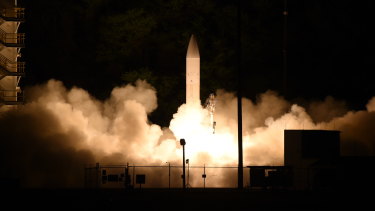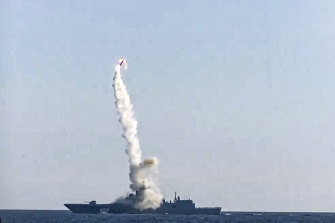A flight test of a hypersonic missile system in Hawaii has ended in failure due to a problem that took place after ignition, the US Department of Defence said, delivering a fresh blow to the program.
It didn’t provide further details of what took placeon Wednesday (US time), but said in a statement sent by email “the Department remains confident that it is on track to field offensive and defensive hypersonic capabilities on target dates beginning in the early 2020s”.
A common hypersonic glide body (C-HGB) launching from the Pacific Missile Range Facility in Kauai, Hawaii in 2020. The Pentagon is developing hypersonic war-fighting capabilities.Credit:US Navy/AP
“An anomaly occurred following ignition of the test asset,” Defence spokesman Navy Lieutenant Commander Tim Gorman said in the statement.
“Program officials have initiated a review to determine the cause to inform future tests.” he said. “While the Department was unable to collect data on the entirety of the planned flight profile, the information gathered from this event will provide vital insights.”
The trial marked the second unsuccessful test flight of the prototype weapon known as Conventional Prompt Strike. There was a booster failure in its first flight test in October, which prevented the missile from leaving the launch pad. The weapon is envisioned to be installed on Zumwalt destroyers and Virginia-class submarines.
The army is developing a land-based version. Lockheed Martin and Northrop Grumman are the top contractors.
Defence is feeling pressure to deploy hypersonic systems as rivals including Russia, China and North Korea are pressing ahead with the systems designed to evade interception by flying at more than five times the speed of sound and gliding on a manoeuvrable path to deliver nuclear warheads.
China is investing heavily in hypersonic weapons, putting one in orbit in July of last year that flew 40,000 kilometres in more than 100 minutes of flight, according to the top US nuclear commander. In January, North Korea conducted two separate launches of hypersonic missile systems that travelled several hundred kilometres.
A new Zircon hypersonic cruise missile is launched by the frigate Admiral Gorshkov of the Russian navy from the White Sea, in the north of Russia, last July.Credit:Russia Defence/AP
Russia debuted a hypersonic air-to-ground missile in its attack on Ukraine. Adversaries don’t have to meet the rigorous standards set under the US defence acquisition system or face public scrutiny over delays and failure.
The slower pace of US hypersonic programs prompted a number of heated exchanges when Defence Secretary Lloyd Austin testified in April before the House Armed Services Committee.
“You recently called in the defence industrial community that were involved in the hypersonics development as to how we can speed that up,” Republican Representative Mike Turner of Ohio said. “We’re behind our adversaries.”
Without denying that, Austin said “we have to be careful” because “hypersonic is a capability, sir, but it’s not the only capability.” He added “I have engaged industry” to “make sure that they’re leaning into” hypersonic development.
Bloomberg
Most Viewed in World
From our partners
Source: Read Full Article







